

EAP Publications | Virtual Library | Magazine Rack | Search
Join the Ecological Solutions RoundtableEAP Publication - 10
S. B. Hill
1 ) Concern about the dependence of our food system on fossil fuel energy has developed only relatively recently, particularly following the "oil crisis" of the early 1970's.
2) Current North American food policies are extrapolative and concerned more with a functioning market than permanent strategies to provide people with an optimal diet.
3) A Normative food policy (emphasizing health, permanence, efficiency, environmental quality and fair rewards for those employed in the food system), responsive to "Natural Laws", should be developed. Predictably, such approaches will reveal that there are numerous possibilities for reducing energy consumption.
4) The success of energy conservation programmes requires value changes within the population, and this is dependent on education and the provision of incentives, particularly by government.
5) The transition from a consumer to a conserver society can be made without undue hardship if started now. The alternative to energy conservation will be energy wars.
6) Increased teaching, research and extension activities in the area of energy conservation should be encouraged and supported. Benefits will be experienced not only in energy conservation, but also environment and human health.
In 1955, Dr. Hugh Nicol, an agricultural chemist, made the following observation:
"Whether we like it or not, the technically-advanced nations must face the position they are in with respect to fuel. It can be stated briefly: industry, transport, and food production are all in competition for a limited supply of fossil fuels" .... (p. 163)
" Very few people are awake to the fact that fuel is as essential to food production on a present-day scale as it is to the continued existence of airlines" .... (p. 191 )
(How bad the situation will become), "in relation to food production will depend on allocations of fuel in relation to food-production" .... (p. 192)
It is ironical that these concerns were not really voiced again in the same way until the early 1970's at the time of the "oil crisis", when tractors in some parts of North America stood still and crops rotted in the field for lack of fuel; and even now the seriousness of the situation is still not widely appreciated. It almost seems as if there is a crises threshold that must be reached before situations, such as this, become apparent to enough people for significant action to be generated. Such crises within our food system may be avoided by re-examining our food policies and re-arranging our priorities.
Contemporary U.S. and Canadian food policies have primarily been designed to provide people with "clean, safe, nutritious and affordable" food, producers with "the opportunity to earn an income comparable to that earned in other sectors" (Whelan & Abbott 1977) and, more recently, nations with "agripower", which the previous U.S. Secretary of State for Agriculture referred to as "one of the principal tools in our negotiating kit" (Butz 1974). Specific policies deal with stabilization, crop insurance, marketing, farm credit, export controls, and subsidies etc. In their latest document on food policy the Canadian Government state "policies must continue to develop and expand Canada's production and export strengths to ensure the adequacy of safe and nutritious food supplies for the domestic and export markets at reasonable prices which are responsive to competitive forces over time" (Whelan & Abbott 1977). They go on to say that while "we need not worry unduly about the sufficiency of food resources or supplies for the forseeable future", we do "need the reassurance that the food marketing system is fair and efficient" and, "while the introduction of new foods and food additives, and the widespread use of agricultural chemicals have increased the concern about health, safety and quality control".... "the main concern of consumers, as with producers, has been the level of food prices". Except for a brief reference to "conserv(ing) scarce resources essential to food production", there is no recognition of the relationships between energy and agriculture in this new "Food Strategy for Canada". Although the document occasionally refers to "nutrition", one has the feeling that it is less important than a functioning market as indicated by the comment that "as more processing, packaging and service is added to raw food products, it is likely that this sector of the food system will attract more attention" (by Government).
There are great dangers in allowing the market system to have such a control over our food, and therefore health, policies. Rather the reverse should be the case. We eat in order to stay healthy and contented and our market system should serve us to this end. However, the market system might be operating perfectly yet at the same time we could be suffering from malnutrition or poisoning, as some people believe we are at the moment (e.g., Hall 1974; Hunter 1977; Mount 1975; Randolph 1962). Similarly there are also dangers in allowing the free market system to determine the fate of agricultural land because, as Hilchey (1973) points out, this "will result in land going to the person or use willing to pay the highest price (and) this will mainly be industry, housing, and recreation". Thus, if not protected by Government "the agricultural industry cannot compete favourably for land under pressure for urban use". This is especially important in relation to our problems with energy, as the energy required to produce food on a piece of land increases rapidly as its area, quality and accessability decline (Figure 1).
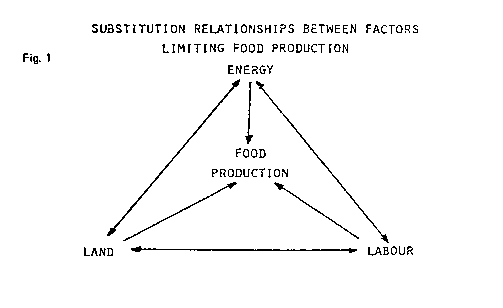
The energy situation, in addition to posing a number of problems, provides us with an opportunity to examine our goals and priorities in the area of food and agriculture. Until now, however, the dominant response has been to try to solve the problems quickly by applying "relatively minor 'leak plugging' end 'fat trimming' economies" and the passing on of "higher costs in the form of higher prices" (Leach 1976). While this approach may appear to work in the short-term, eventually we will have to make more radical changes as the supplies of oil and gas and, later on, the high fossil fuels become scarce.
The new food strategies outlined by the Canadian Government essentially commit us to "more of the same" and consequently, to further increases in energy dependence and reductions in energy efficiency within the food system. If these are pursued without introducing energy conserving strategies at the same time, it will become increasingly difficult for us to implement the changes that will eventually be necessary. The normative approach, used with some success by Amory Lovins (1976), is one means of dealing with this situation. He suggests that by first establishing long-term goals (e.g., 50 years) and working back to the present (in order to see how to achieve them), new and unexpected policy paths become apparent that would not be seen by working foreword by what he calls "incremental ad-hocracy". Thus, by following an extrapolative approach we might not realize until "2010 that we could have gone in a very different direction if we had only thought of it in 1980, before it was too late" (Lovins 1976).
A normative approach has been used to generate the food policies listed in Table 1. The national goals focus on health, permanence, efficiency, environmental quality and fair rewards for those employed in the food system. These are normative in that they are concerned with long-term or "global" objectives. There is a great difference between providing food for health and providing "cheap clean food that is nutritious" (knowing that the study of nutrition is still at an early stage of development and somewhat culture-bound, and therefore subjective in its judgements). This has important implications for the energy and agriculture situation. Hence, by working backwards from health to the optimal diets of individuals one can discover what the food system should be producing. Predictably, such a system would be required to produce little or no foods to be consumed in highly processed forms, as nearly all foods are nutritionally superior in their elemental states (Hall 1974). This is significant with respect to the use of energy in agriculture because processing is responsible for over 35% of the energy consumed in the Canadian food system (Warkentin 1976). Savings in terms of reduced nutrient losses at this stage of the food chain would represent a saving in acreage required for food production and therefore, also in energy. In addition, there would be cutbacks in the production of many other energy foods, such as feedlot beef (Pimentel et al. 1975).
Similarly, if we examine the implications of a "permanent" food system, further energy savings can be realized. Such a system would imply the return of organic wastes to the soil and the use of nitrogen fixing crops in rotation. Systems employing these strategies require less energy and cause less environmental degradation than monocultures relying on inorganic fertilizers (Hill & Ramsay 1977). In one study "organic" farms, employing some of these methods, were found to operate on two fifths the amount of energy of conventional farms while maintaining almost the same level of productivity (Lockeretz 1978).
Emphasis on "appropriate and efficient strategies" (the third goal) will result in further savings in energy.
In achieving the fourth goal, an "optimal spatial environment" individuals will come to place more value on Quality of Life (Table 2) and less on material consumption, thereby saving more energy.

By providing those employed in the food system with a "fair wage and acceptable working conditions" we can help prevent the migration of rural populations to our cities. This will, in turn, make more labour available on the farm and hence reduce the requirement for non-renewable energy.
At the international level it is imperative that "developed" countries desist from encouraging energy addiction within the food systems of LDC's, as they have been doing through the promotion of approaches such as those embodied in the Green Revolution.
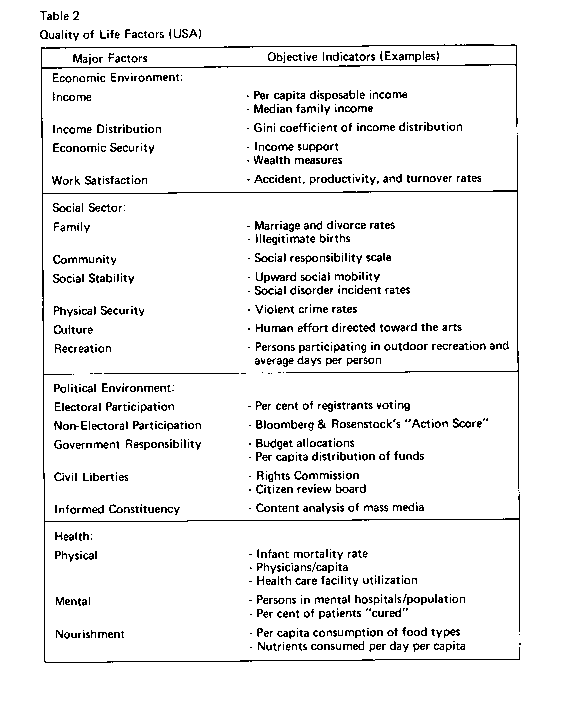
It should be noted, however, that in the short-term, until agriculture can be re-organized in order to produce its own energy, the food system will be as affected by patterns of energy consumption and conservation outside the system as within it.
Thus, in order to ensure the success of a regional agricultural energy conservation program it must be part of a general program that is, at least, national in extent. Three primary factors that are influential in this respect: population density, distribution and activities (Figure 2). Hence, a highly aggregated, high density consumer society is energy expensive, while a dispersed, low density conserver society is not (Chen & Lagler 1974, Science Council of Canada 1977). Differences in transportation costs and ease of recycling are particularly important in this comparison.
The most apparent feature of this normative approach is that there is great potential to reduce energy consumption at all levels within the food system.
Another requirement of a normative approach is that in selecting strategies 'Natural laws and Constraints' be respected. Four such laws, relevant to the energy and agriculture situation, are listed with their implications in Table 3. As can be seen from the policy implications listed, conformation to each of these laws will result in energy savings over the long-run.
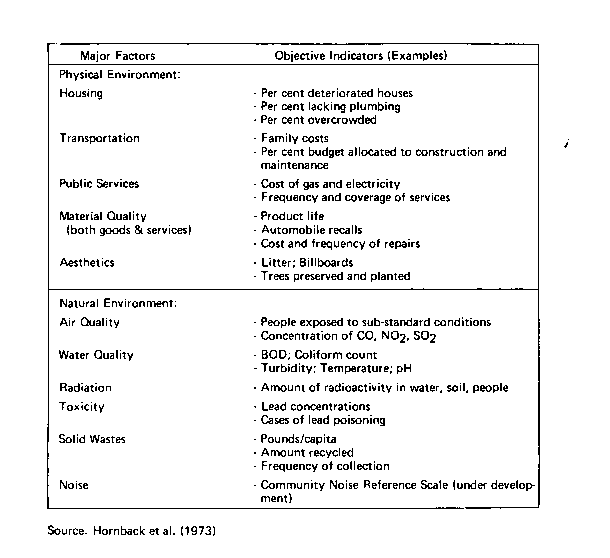
It should be noted, however, that the policies being generated in most countries today are extrapolative rather than normative, often being in response to crises. An example of such policy is provided by a statement on energy and agriculture made recently by a prestigious group of American agricultural engineers (Anon 1977b):
"1. Energy conservation must be developed and practiced in the food system.
2. Fuels which are plentiful and renewable must be substituted for fuels in short supply.
3. Alternative energy sources that originate from or are especially suited to the food system must be developed and used."
4. Sectors of the food system must be assigned priority use of petroleum where no other fuel is available for operation of heavy duty mobile work vehicles.
Sectors of the food system must be assigned priority use of natural or synthetic gas for those operations in which no substitute fuel has been developed".
While these are reasonable statements, and very representative of policy being generated in the developed world at this time, their long-term success will require that emphasis be placed on the third recommendation and that they be part of a broader energy policy extending to other sectors of society.
It is important to realize that greater energy savings can be made within the food system by consumers changing their patterns of consumption, than by engineers tuning machinery or developing alternative non-renewable sources of energy, although the latter approaches should certainly not be neglected. For a significant number of consumers to change, two conditions must be satisfied (C.A.S.T.1976):
1. a wide understanding of the problem and approaches towards a solution
2. incentives for change
The role of government is central to energy conservation programmes because of its access to vast information systems that can be used to inform people.
More important than energy substitutions by engineers, is value substitutions by people; from quantitative growth to qualitative growth, from more to better. This will involve, among other things, a reassessment of the factors that determine "Quality of Life". The early stage that we are at in this process is illustrated by reference to those factors listed in Table 2. Our inexperience in considering Quality of Life is apparent from this mixed bag of criteria summarized by Hornback et al. (1973). What is most evident is the lack of sensitivity to individuality. For example, nutritionally an individual, rather than needing to consume certain "food types" in certain amounts "per day", has to satisfy his or her own unique requirements, which may vary from those of another individual for certain items, by more than 100% (Williams 1973); access to the so called optimal diet may cause toxicity symptoms or allergic reactions in one individual and deficiency symptoms in another (Dickey 1976) Nutrition is not unique in this respect, but rather typical. On the other hand, generalizations can be made in the area of "non-nutritious" foods. As Cheraskin (1976) has pointed out, our bodies have no requirement for refined sugars or for most of the food additives that are included in nearly all processed foods. There is also no need to cook most fruits and vegetables or to eat exotic foods that have to be imported, at great energy costs, from the tropics.
If we learned to give up some of these things, give up our pets and cut down on our drinking, smoking and meat eating, enormous energy savings would be realized within the food system. As each of us in the industrialized world uses between 10 and 100 times as much energy per day than is actually required to keep us alive (through food), we have plenty of opportunities to conserve.
Slesser (1974) in an effort to illustrate the difference between values and costs tells the following story:
Imagine being "one of 200 other (intelligent) people trapped on a remote island, without hope of rescue, but with the remains of the jetliner and a bit of food, fuel, scraps of metal, and so on. It would not take them long to decide how best to allocate their non-renewable resources. Some, like the metal bits and pieces, could be recycled or re-assembled. Hopefully someone would find some seeds and agriculture might get under way. One could perhaps raise turtles and wild boar; the sun would supply a daily ration of solar energy, and occasionally it would rain. But of all the residual supplies, the unburnt fuel in the jetliner's tank would be the most precious. In clever hands it could do many things, for that fuel would be the only intensive energy available to them, capable of melting metal, running motors, sending radio signals or making fertilizers. They might, if they had the konw-how amongst them, decide to devote their last remaining supplies of fuel to making solar cells, and thus ensure a perpetual supply of a somewhat more intense energy. But whether they did this or not, the stored energy supply available to them on this island would be limited. Realising this, they would use it with infinite care. Faced with the choice of doing a task by one of several routes, they would take considerable care that they did it by the least intensive energy route.
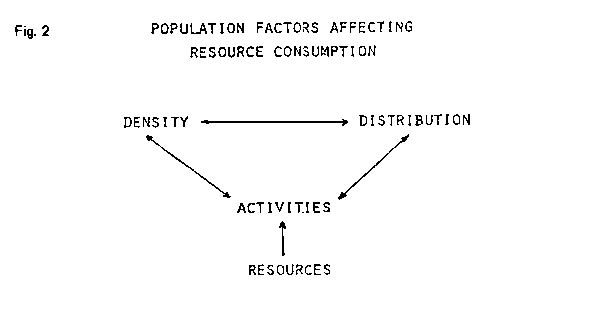
Early on, they would discover a very significant fact. Namely, that if they did things with careful design, without undue haste, awaiting the development of each step, they would be able to achieve a lot more with their limited supply of fuel energy than if they embarked upon some crash programme."
The longer that we postpone establishing a program to enable individuals to attain the wisdom gained by the above members of the imaginary plane crash, the more difficult it will become to develop the conserver ethic. If the peoples of the world do not become energy conservers there will undoubtedly be Energy Wars.
Hugh Nicol in 1955 speculated what North America might be like in the year 2154 after four such wars:
"There is still some coal left in the United States (and Canada) but it lies so deep that there is not enough ore to equip the mines with the elaborate installation needed to get it out. The nation's population is now, therefore, in balance with what the land can produce.
How the population declined from its maximum of two hundred million or so is not exactly known, owing to long prevalence of chaotic conditions before a natural equilibrium was attained.
The greatest drop was after Fuel War 2. This had been fought between the nations who badly wanted fuel for their agriculture and fishing-fleets, and the others who wished also to go on burning fuel in their automobiles and civil airplanes..."
"Unlike the wars of the twentieth century, Fuel War 3 was relatively expensive in fuel, since the struggle for what was accessible used up much of what was left. Casualties were fairly light in what is called Fuel War 4; though this was not really about fuel, but about the last ores. It was fought mainly in Africa, and was followed by what seems to have been the last great decline in white population".
It is important to realize that at this point in time we have a wide range of choices available to us, in particular, we have access to fossil fuels, which can be used to make the transition from a non-renewable (capital) based society to a renewable (income) based one without discontinuites or undue stress. It is vital that we recognize this because from this point on our choices diminish.
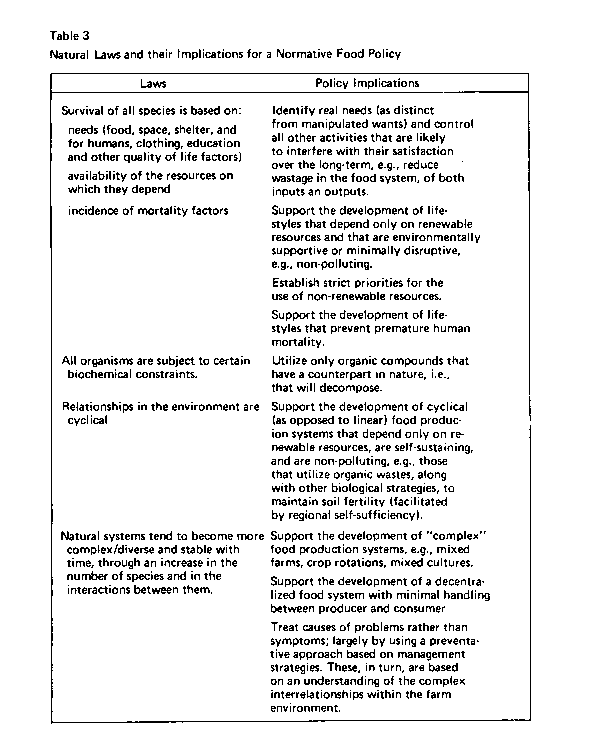
Some Current Responses
Some, such as Stoskopf (1976), argue that "before strategies for greater energy efficiency can be suggested and implemented it is first necessary to determine the efficiency or inefficiency of energy inputs as food on the table, and having pinpointed the high energy consuming and/or wasteful areas, to suggest or find improved techniques that will increase efficiency and help conserve energy". There are already numerous strategies available to us to conserve energy and reduce energy inefficiency within the food system. Initiating further studies has become an acceptable way of postponing responsible action. Certainly further studies are required, but mostly in order to monitor the effectiveness of conservation programs and to improve energy efficient methods of food production and handling.
One positive response to the energy situation in Canada has been the establishment of the Institute of Man and Resources in Prince Edward Island (Anon. 1975). Among their stated objectives are:
a) "The mobilization of talent and resources for the analysis, invention, adaption and application of appropriate energy, food and crop production and living and shelter systems which are socially desirable and ecologically sustainable, and the assessment of probable impacts of such systems"
b) "the analysis, adaption, testing and demonstration of environmentally appropriate agricultural, aquacultural, horticultural, silvicultural and animal husbandry systems which reduce dependence on non-renewable resources, inorganic fertilizers and other agro-chemicals and on inappropriate equipment"
c) "support to individuals, groups, communities and government seeking to resolve their energy and food problems"
d) "the acquisition and dissemination of information relating to appropriate energy and food production systems"
The establishment by Governments of Institutes such as this should be encouraged as it can only improve the food system over the long-term, not only in relation to energy conservation but also to environmental conservation, food quality and human health.
Zusammenfassung
Die Energieverhaltnisse und deren Konsequenzen fur die Nahrungsmittelstrategie
1 ) Eine echte Besorgnis liber die Abhangigkeit unseres Nahrungsmittelsystems von fossilen Brennstoffen ist erst in neuerer Zeit manifest geworden, insbesondere als Folge der Oelkrise der 70er Jahre.
2) Die gegenwartige Nahrungsmittelstrategie in Nord-Amerika befasst sich mehr mit dem Funktionieren des Marktes als mit langfristigen Uberlegungen fur die Versorgung der Bevolkerung mit Biner optimalen Ernahrungsgrundlage.
3) Es erscheint dringend notwendig eine Nahrungsmittelstrategie zu entwickeln, die sich vermehrt mit Gesundheit, Dauerhaftigkeit der Produktion, Effizienz, Umweltqualitat und fairer Entlohnung der in der Nahrungsmittelproduktion Tatigen auseinandersetzt. Hierdurch durften sich auch eine Vieizahl von Moglichkeiten fLir eine Energieersparnis ergeben.
4) Der Erfolg von Programmen zur Energieersparnis hangt sehr stark davon ab, inwieweit Wertveranderungen in der Bevolkerung erreicht werden konnen. Eine besondere Rolle spielt die Erziehung.
5) Der Ubergang von Biner Konsum- zu Biner Erhaltergesellschaft konnte ohne grosse Probleme vor sich gehen, wenn jetzt damit begonnen wurde. Die Alternative zur Energieersparnis heisst namlich Energiekriege.
6) Es erscheint notwendig die Forschung, Lehre und auch die Beratung auf dem Gebiet der Energiekonservierung zu intensivieren und aktiv zu unterstutzen. Es werden sich dann nicht nur Vorteile auf dem Gebiet der Energieersparnis ergeben, sondern auch bzgl. Umwelt und Gesundheit.
Resume
La situation energetique et ses implications quant a la strategie alimentaire
1) II faut prendre en consideration le fait que notre systeme alimentaire dependant de l'utilisation de l'energie fossile s'est developpe relativement recemment, particulierement a la suite de la "crise du petrole" du debut des annees 1970.
2) La tactique alimentaire courante en Amerique du Nord se base sur des extrapolations et s'occupe plus des exigences du marche que des besoins a plus long terme pour fournir a l'humanite une alimentation optimale.
3) II s'agit de developper une strategie alimentaire normative, en accord avec les lois naturelles, mettant l'accent sur la sante, la permanence, I'efficacite, la qualite de l'environnement et penalisant sans ambiguite les techniques actuelles. De telles approches revelent ltexistence de nombreuses possibilites servant a reduire la consommation d'energie.
4) Le succes des programmes de conservation et d'economie d'energie necessite un changement de mentalite dans la population, permis par le systeme educatif et favorise par des primes offertes par le gouvernement en particulier.
5) La transition d'une socitete de consommation vers une societe de conservation peut se realiser sans difficultes insurmontables si elle debute maintenant. La seule alternative possible a la conservation de l'energie sera la guerre pour l'energie.
6) II faut encourager et soutenir des initiatives toujours plus nombreuses en rapport avec la conservation de l'energie dans l'enseignement, la recherche ou d'autres activites. Les benefices s'en feront sentir non seulement dans le domaine energetique mais egalement pour l'ensemble de l'evironnement et pour la sente humaine.
Resumen
Las relaciones de la energia y sus consequencias por la industrie de alimentacion
1 ) Hace farta tomar en consideraci6n el hecho de que nuestro sistema alimenticio dependiente del uso de la energia fosil se desarrollo relativamente recientemente, particularmente a continuacion de la "crisis del petroleo" del principio de los anos 1970.
2) La tactica alimenticia corriente en America del Norte se basa sobre unes extrapolaciones y se preocupa mas de la exigencias del mercado que de las necesidadeu a mas largo plazo para proporcionar a la humanidad une alimentacion optima.
3) Se trata de desarrollar une estrategia alimenticia normative, de acuerdo con las leyes naturales, subrayando la salua, la permanencia, la eficacia, la calidad del medio ambiente, y castigando sin ambiguedad las tecnicas actuales. Tales aproximaciones revelan la existencia de numerosas posibilidades sirviendo a reducir el consumo de energia.
4) El exito de los progra mas de conservaci on y de economia de energi'a necesita un cambio de mentalidad en la poblacion, permitido por el sistema educativo y favorecido por primas of recidas por el gobierno en particular.
5) La transicion de une sociedad de consumo hacia une sociedad de conservaci6n puede llevarse a cabo sin dificultades infranqueables si sempieza ahora. La unica alternative posible a la conservacion de la energia sera la querra para la energia.
6) Hace farta alentar y sostener iniciativas caca vez mas numerosas en relacion con la conservacion de la energi'a, en la ensenanza, la investigacion u otras actividades. Los beneficios se notaran no solo en el ambito energetico sino tambien para todo el entorno y para la salua humana.
ANON. 1975. An act to incorporate the Institute of Man and Resources. Queen's Printer, Charlottetown, P.E.I.
ANON. 1977. Energy policy for the U.S. food system: A sub-part of a national energy policy. Dept. Agr. Eng., Cornell Univ., Ithaca, NY. 26 pp.
BUTZ, E. 1974. Report of tris remarks at the 1974 World Food Conference in Rome. p. 84 in: Anon. The World Food Crisis: What to do: costly choices. Time Nov. 11, 1974.
CAST, 1975. Potential for energy conservation in agricultural production. Council Agric. Sci. Tech. No. 40
CHEN, K. and K.F. Lagler, eds. 1974. Growth Policy: Population, Environment and Beyond. 237 pp. U. Mich. Press., Ml.
CHERASKIN, E., W.M. Ringsdorf Jr. and A. Brecher. 1974. Psychodietics. 228 pp. Stein and Day, NY.
DICKEY, L.D. ed. 1976. Clinical Ecology. 807 pp. Chas C. Thomas, Springfield, IL.
HALL, R.H. 1974. Food for Nought: the Decline in Nutrition. 292 pp. Vintage Books, Random House, NY.
Hl LCHEY, J.D. 1973. Long term planning in resource development and use. Agrologist 2 (4): 9 - 11.
Hl LL S. B. and J.A. Ramsay. 1977. Limitations of the energy approach in defining priorities in agriculture. Pp. 713-731 in W. Lockeretz (ed.) Agriculture and Energy 750 pp. Academic Press, NY.
Science Council of Canada 1977. Canada as a Conserver Society. 108 pp. Supply and Services Canada, Ottawa.
HORNBACK, K.E., J. Guttmann, H. L. Himmerstein, A. Rappaport and R. Reyna. 1 973. Studies in environment. Vol. 2. Quality of Life. 113 pp. EPA-600/5-73-012 b. U.S.G.P.O., Wash., DC.
HUNTER, B.T. 1975. The mirage of safety. 322 pp. Chas. Scriboer's Sons, NY.
LEACH, G. 1976. Energy and food production. 137 pp. IPC Sci. Tech. Press, Guilford, Surrey, Engl,
LOCKE RETZ, W. R. 1978. Economic and Resource Comparison of Field Crop Production on Organic Farms and Farms Using Conventional Fertilization and Pest Control Methods in Midwestern United States. Pp. 157-169 in J.M. Besson and H. Vogtmann (eds.).
Towards a Sustainable Agriculture. Proc. IFOAM Int. Conf.,Sissach, Switzerland, 1977. 243 pp. Verlag Wirz Aarau, Switzerland.
LOVINS, A. 1976. Exploring energy - efficient futures for Canada. Consumer Soc. Notes 1 (4): 5 - 16.
MOUNT, J.L. 1975. Food and health of western man. 270 pp. Charles Knight and Co, Lond.
NICOL, H. 1955. Microbes and Us. Pelican Books, Harmondsworth, Middx., Engl.
PIMENTEL, D., W. Dritchelo, J. Krummel and J. Kutzman. 1975. Energy and land constraints in food protein production. Science 190: 754- 761.
RANDOLPH, T.G. 1962, Human ecology and susceptibility to the chemical environment. 148 pp. Chas. C. Thomas, Springfield, IL.
SLESSER, M. 1974. The energy basis of development. Chem. Engineer 284: 231 - 46.
STOSKOPF, N.C. 1976. The current energy use situation in food production. Notes on Agriculture (U. Guelph) 12 (4): 19- 20.
WHELAN, E.F. and A.C. Abbott. 1977. A food strategy for Canada. CDA., Ottawa. 21 pp.
WILLIAMS, R.J. 1973. Biochemical individuality. 214 pp. U. Texas Pr., Austin, TX.
Based on part of a study for the New Brunswick Government by S.B. Hl LL and J.A. RAMSAY (1977) entitled "Energy and the Canadian Food System with Particular Reference to New Brunswick".
Dr. Stuart B. HILL P.Q. Box 301 Macdonald Campus of McGill University Ste. Anne de Bellevue Montreal Island, Quebec CANADA HOA 1C0
Copyright © 1977